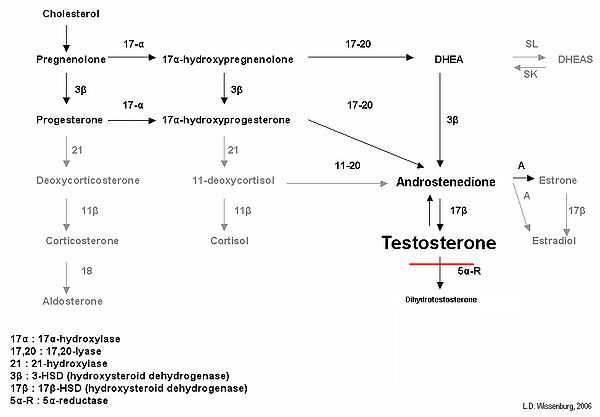5-alpha-reductase deficiency
| 5α-reductase deficiency | |
|---|---|
| Classification and external resources | |
 5-alpha reductase produces dihydrotestosterone | |
| ICD-10 | E29.1, Q56.3 |
| ICD-9 | 257.2, 752.7 |
| OMIM | 264600 |
| DiseasesDB | 11 |
| eMedicine | ped/1980 |
5α-Reductase deficiency (5-ARD) is an autosomal recessive intersex condition caused by a mutation of the 5α reductase type II gene.[1]
Normal function
5α-Reductase is an enzyme that converts testosterone to 5α-dihydrotestosterone (DHT) in peripheral tissues. These enzymes also participate in the creation of such neurosteroids as allopregnanolone and THDOC, convert progesterone into dihydroprogesterone (DHP), and convert deoxycorticosterone (DOC) into dihydrodeoxycorticosterone (DHDOC). 5-ARD is biochemically characterized by low to low-normal levels of testosterone and decreased levels of DHT, creating a higher testosterone/DHT ratio.

DHT is a potent androgen, and is necessary for the development of male external genitalia in utero.
Signs
The condition affects only genetic males (that is, usually, those with a Y-chromosome) because DHT has no known role in female development.[2]
Individuals with 5-ARD can have normal male external genitalia, ambiguous genitalia, or normal female genitalia. They are born with male gonads, including testicles and Wolffian structures, but usually have female primary sex characteristics. As a consequence, they are often raised as girls, but usually have a male gender identity.[3][4]
In general, individuals with 5-ARD are capable of producing viable sperm. In individuals with feminized or ambiguous genitalia, there is a tendency towards a macroclitoris or micropenis, and the urethra may attach to the phallus. This structure may be capable of ejaculations as well as erections, but may be insufficient for intercourse.
At puberty, individuals often have primary amenorrhoea and may experience virilization. This may include descending of the testes, hirsutism (facial/body hair considered normal in males - not to be confused with hypertrichosis), deepening of the voice, and enlargement of the clitoris. In adulthood, individuals do not experience male-pattern baldness.[1] As DHT is a far more potent androgen than testosterone alone, virilization in those lacking DHT may be absent or reduced compared to males with functional 5-AR. It is hypothesized that rising testosterone levels at the start of puberty (around age twelve) are able to generate sufficient levels of DHT either by the action of 5α-reductase type I (active in the adult liver, non-genital skin and some brain areas) or through the expression of low levels of 5α-reductase type II in the testes.
Infertility
5-ARD is associated with an increased risk of cryptorchidism and testicular cancer. Fertility is further compromised by the underdevelopment of seminal vesicles and prostate.
On the other hand, fertility depending on female characteristics is impossible; although the external genitalia may be female, the vagina consists of only the lower two-thirds of a normal vagina, creating a blind-ending vaginal pouch. Due to the normal action of Müllerian inhibiting factor produced by the testes in utero, individuals with 5-ARD lack a uterus and Fallopian tubes. Thus, individuals with 5-ARD are not able to carry a pregnancy, and, since they have testes and not ovaries, they are unable to create ova, which precludes such infertility treatments as surrogate motherhood.
Prevalence
The number of people with this condition varies relative to geographic location, depending on how much of a given population is interrelated.[citation needed] In a small remote village in the Dominican Republic 12 out of 13 families were affected. Here, the incidence was 1:90 males.[5] The Spanish term for a person with the condition is "guevedoche" or "guevedoce". This comes from the phrase "huevos a las doce" meaning "eggs at twelve".
In Popular Culture
In the Nip/Tuck season three episode "Quentin Costa", it is revealed that Dr. Quentin Costa had 5-ARD.
Jeffrey Eugenides' Pulitzer Prize-winning 2002 novel Middlesex is about a young man with 5-ARD. The character was originally born Calliope and raised as a girl, but upon realizing his true biological sex, he transitions into Cal. Eugenides himself does not have the deficiency.
See also
- Inborn errors of steroid metabolism
- Disorders of sexual development
- Intersexuality, pseudohermaphroditism, and ambiguous genitalia
- 5α-Reductase (I, II)
- Androgen (testosterone and dihydrotestosterone)
References
- ↑ 1.0 1.1 5-alpha reductase deficiency at GPnotebook
- ↑ eMedicine article on 5-ARD
- ↑ Praveen, EP; Praveen EP, Desai AK, Khurana ML, Philip J, Eunice M, Khadgawat R, Kulshreshtha B, Kucheria K, Gupta DK, Seith A, Ammini AC. (February 2008). "Gender identity of children and young adults with 5alpha-reductase deficiency.". J Pediatr Endocrinol Metab. (2 ed.) 21 (2): 173–179. PMID 18422030.
- ↑ Imperato-Mcginley, Julianne; Julianne Imperato-McGinley, M.D., Ralph E. Peterson, M.D., Teofilo Gautier, M.D., and Erasmo Sturla, M.D. (May 31, 1979). "Androgens and the Evolution of Male-Gender Identity among Male Pseudohermaphrodites with 5α-Reductase Deficiency". New England Journal of Medicine 300 (22): 1233–1237. doi:10.1056/NEJM197905313002201. PMID 431680.
- ↑ Imperato-McGinley, Julianne; Guerrero, Luis; Gautier, Teofilo; Peterson, Ralph Edward (December 1974). "Steroid 5alpha-reductase deficiency in man: an inherited form of male pseudohermaphroditism". Science 186 (4170): 1213–1215. doi:10.1126/science.186.4170.1213. PMID 4432067.
External links
- OMIM article
- 5α-Reductase Deficiency at eMedicine
- "Whatever I feel..." Article in the New Internationalist
- "Guevote: The Way I Feel Is How I Am" A film by Rolando Sánchez
| |||||||||||||||||||||||||||||||
| ||||||||||||||||||||||||